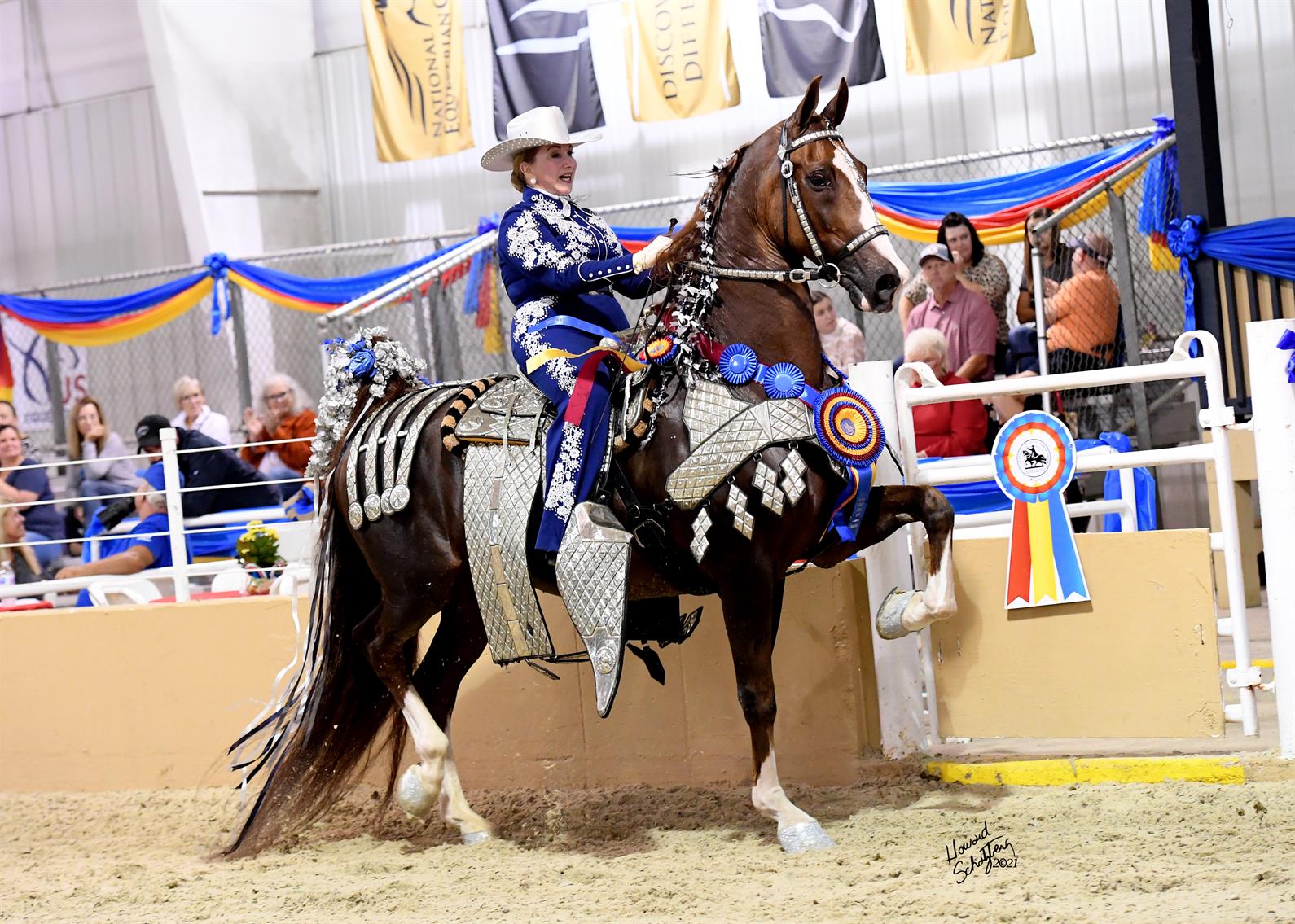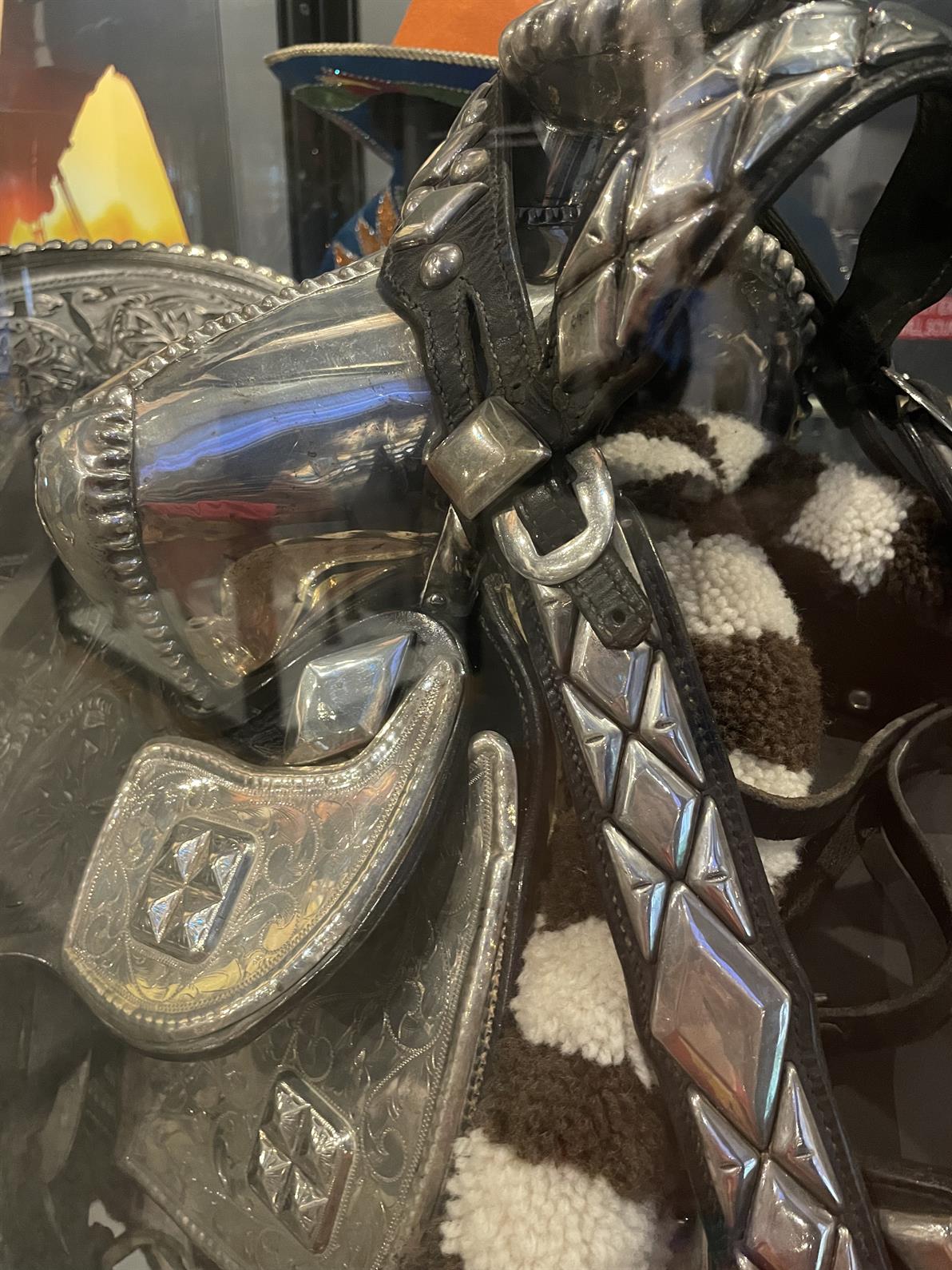The history of the parade discipline can be traced back centuries, both to the British monarchy and ranch owners in the American Southwest. Famous for their silver Western tack and elaborate costumes, parade horses and their riders can be seen in both street parades like the Rose Parade in Pasadena, California, and parade classes at horse shows.
Ashley Hallock has shown American Saddlebreds for over 30 years and ridden in multiple parades, including the Tournament of Roses Parade. Hallock attributed the rise in parade horses’ mainstream popularity to the “Hollywood cowboy” image of the 1950s and 1960s.
“That era of the ’50s and ’60s was where the Hollywood cowboy, John Wayne, the Lone Ranger, Roy Rogers, Hopalong Cassidy, etc. were popular,” Hallock said. “I think the popularity of that kind of Hollywood cowboy then translated over into the horse community and then got translated into the parade classes.”
Parade rider Joan Todd said she got involved with the discipline after being impressed by its flashy aesthetics as a child.

“When I was a little girl, parade was kind of in its heyday, and I was absolutely bedazzled. The classes were big, you've got tons of bling, you've got these beautiful ladies on these big, fancy horses that are dripping in silver, and I thought it was the coolest thing I had ever seen,” Todd said.
After Todd purchased a restored parade equipment set designed by Ted Flowers, she asked her trainer, Shelley Fisher at Sugar Knoll Farm in Dayton, Ohio, if she'd be willing to try the parade division. Her next step was obtaining her half-Saddlebred, CH-HS Candor, or “Chuck.” Before Todd bought Chuck in May of 2019, he was owned by his breeder, Kari Lundin.
“I kind of put (parade riding) on the shelf for a long time, and I showed in every other division, but the wish never left me,” Todd said. “It was really the fulfillment of a lifelong dream that never left me, and I decided, ‘What the heck, I'm going to do it before I can't do it.’”
The parade discipline is not breed-specific. Many different breeds can participate and meet the criteria to be a good parade horse.
“What you have to do in a parade class is theoretically what you should be able to do in a street parade. You have to halt and stand quietly, like if you were in a parade and a float broke down,” Hallock said. “Usually, the parade gait is five miles per hour, and that's based on the flow of how a street parade would work.”
American Saddlebreds, Morgans, and Hackneys are popular breeds within the parade discipline. James Lowry, along with his wife Fay, trains all three of these breeds at High Spirits Farm in Ashland, Missouri. One of the ponies the Lowrys trained is Susan Courtney’s Hackney pony CH Velvet King, who won the 2022 Parade National Champion title at the 2022 UPHA American Royal competition, competing with Lillia Shope.
“Pretty much most [parade classes] are open,” Lowry said. “Some are American Saddlebred classes, and obviously at the Grand Nationals for Morgans, they're Morgan classes. But there's lots of open ones also.”
Lowry explained that the quality of their gait is the main aspect that identifies a good parade horse. Parade horses are shown at two main gaits: an animated walk and a high-stepping parade gait.
“If it's a very forward-going horse [with a] long stride, it's not going to be a good parade horse. So we're looking at something that's got more up-and-down motion,” Lowry said.
“The horse must have a lot of animation and go very slow. Anyone who's done dressage or any of those other disciplines understands how athletic that horse must be to do that and do it well,” Todd added. “The specifications require that you not go over seven miles an hour. Chuck is 17-plus hands; that's a tall order for a big horse like that. A big, powerful horse is used to going forward.”
The expectations of a parade horse vary, depending on whether they are participating in a horse show or street parade, despite the similarities between the two environments. Hallock said that many horses that are successful in parade show rings might not have similar success in street parades.
“If you're doing parades on the level of the Rose Parade, you might have a marching band behind you beating drums and playing trumpets, and in front of you, you might have cheerleaders throwing people up in the air,” Hallock said. “It takes an exceptionally broke horse to do that.”
Hallock said it is often hard to tell if a horse will be a good street parade horse, since they have to balance being both controlled and animated.
"You kind of know based on their disposition, but you really don't. It's just trial and error,” Hallock said. “The only way you can really know is you just have to take him to a parade and try that first time. Start local with little local parades and see how they take it.”
Another trait of a proficient parade horse is its ability to carry the equipment, which is often made of silver.
“Most of them are truly antiques,” Lowry said. “Many of them need to be refurbished. And they're extremely heavy and large, but really cool. And some are extremely valuable; some are very expensive.”

“Even the less expensive full silver sets run between $6,000 to $10,000, so that expense probably is intimidating for a lot of people,” Hallock said. “Getting a horse ready to show in a parade class is itself a one-to-three-hour process from start to finish, so I think all those things combined just made it a little overwhelming for a lot of people.”
Hallock advised that those looking to become involved in parade riding find community and like-minded people in their area. She recommended finding equipment and collaborators through Facebook or other social media.
“You can get used parade sets; it's still an investment, but if you're just starting, you can get one at a reasonable cost. A lot of people have homemade outfits that they make to start out with to keep things more economical,” Hallock said.
“There's so few people, but there are certain people that have gone out of their way to collect that [equipment], and that's how you source it,” Lowry said.
Todd acknowledged that maintaining her horse and his equipment is time-consuming. She works with Bob Glessner at Loon Creek Leather in Huntington, Indiana, to maintain and repair her saddles and other equipment.
“Leather and metal rub together, and they deteriorate each other, so you have to be vigilant because you don't want a disaster in the middle of the class. And I've had that sometimes. You just need to have a good crew and a good saddle-maker standing by,” Todd said. “I always say carry a lot of black electrical tape, because you may need it when you least expect it.”
Many parade riders also collaborate and share equipment with other parade athletes. Hallock collaborated with Michele Macfarlane, while Lowry sourced equipment and connections from Suzanne Bradshaw.
Both Lowry and Hallock said their favorite aspect of parade horses is the “glitz” and ambience of the competition ring.
“It's something very unique,” Lowry said. “A lot of people say even non-horse show people will enjoy it. It's not too hard to understand a good parade class.”
“I like making a beautiful presentation. This is a crowd-pleasing class,” Todd said. “I have a beautiful horse that's beautifully trained, beautifully turned out, and is stepping beautifully. And the crowd is into it. That's my favorite part.”
Hallock also has noticed an uptick in amateur participation in parade classes.
“For a lot of people, it's a commitment they have to dedicate themselves to,” Hallock said. “Hopefully, more people like that will start recognizing how important it is because it's a very historical class. I hope it sticks around.”
Clearly, though the parade community is small, it still has its fans and dedicated participants. Many parade riders have seen a gradual spread in participation recently thanks to this community; Hallock even advised new riders to look for local shows in their area, as this may eliminate the need to travel to areas with more prominent parade competitions.
“We have a really good group of diehards that are keeping this alive. It's very big in Ohio, where I live. It's big in Kansas. I've seen some classes in Minnesota. It's been popular in Indiana as well, and it's also in Missouri,” Todd said.
“It's really cool if you get to do it, very glamorous,” Lowry added.
Visit USEF’s page about parade horses to learn more about parade horses.


